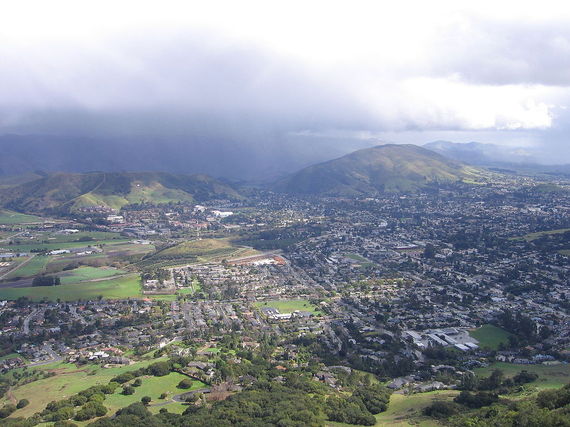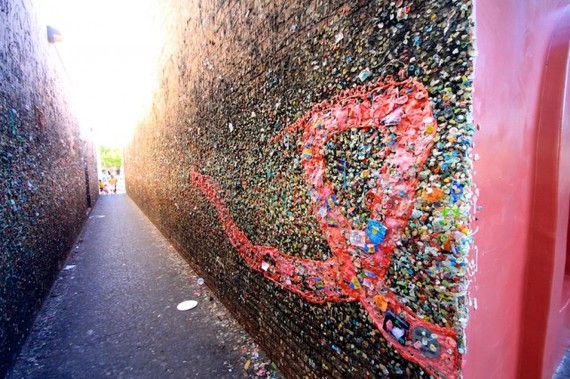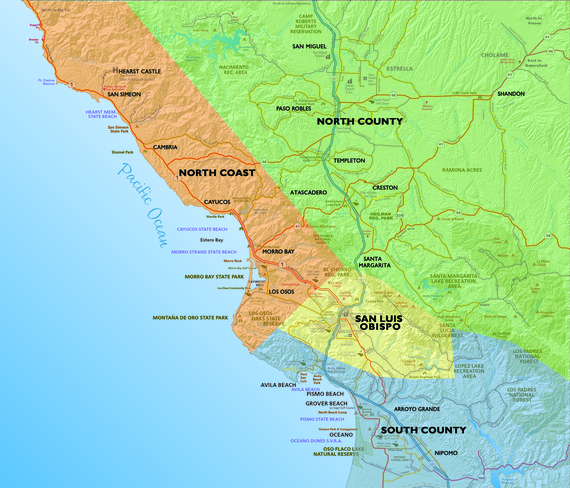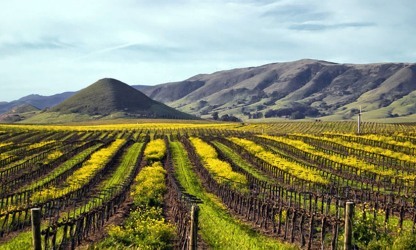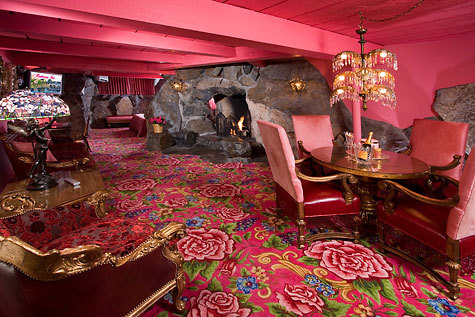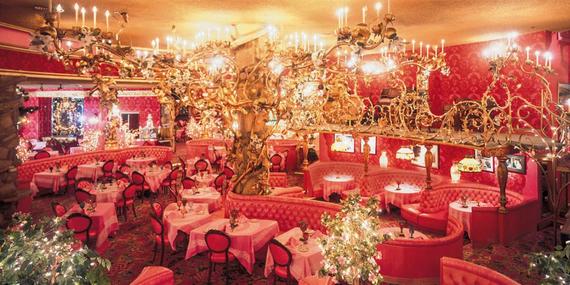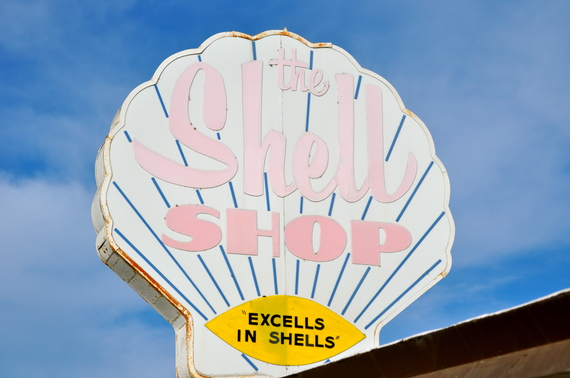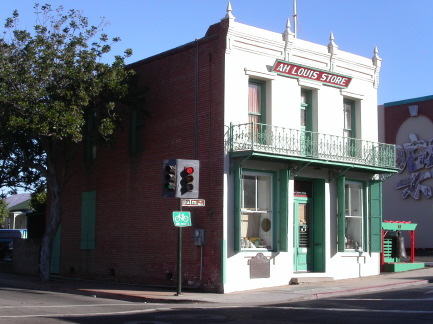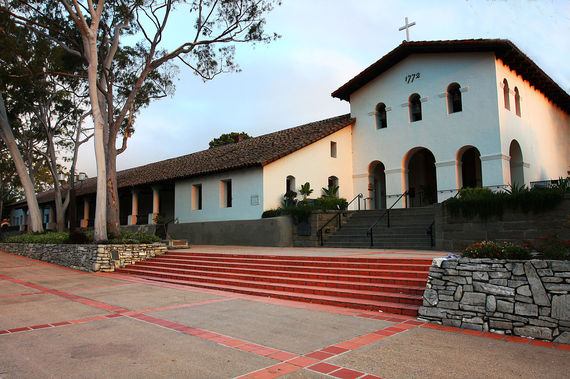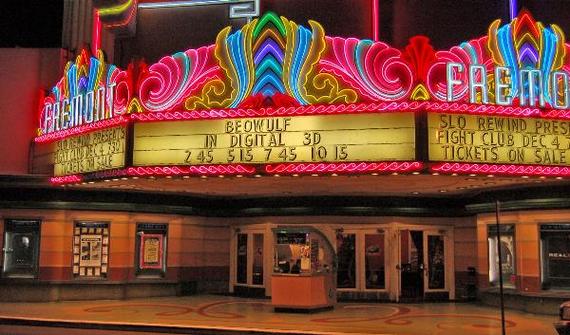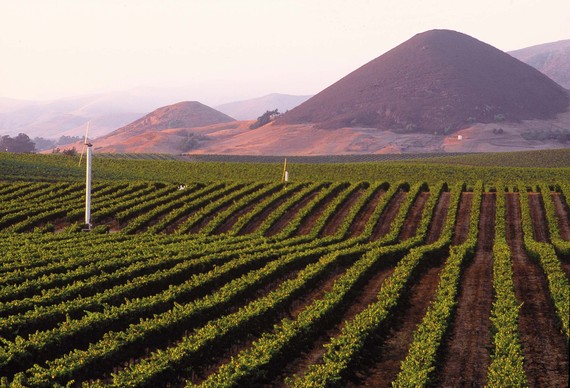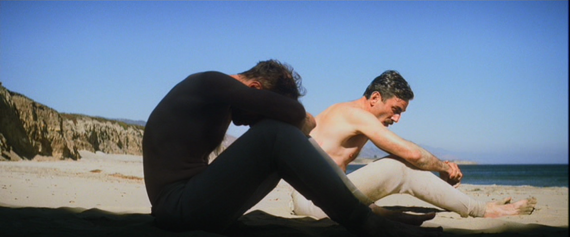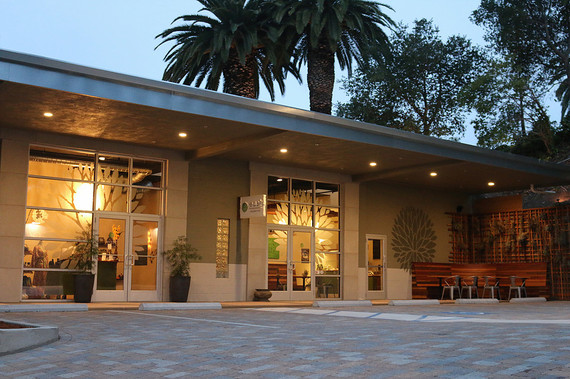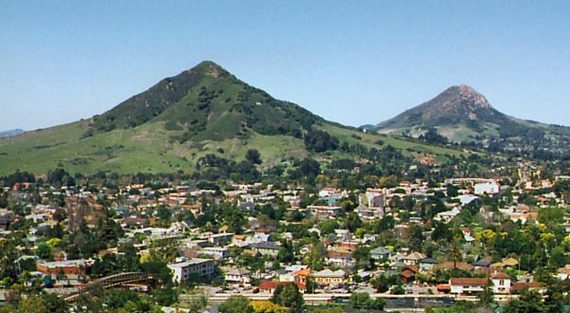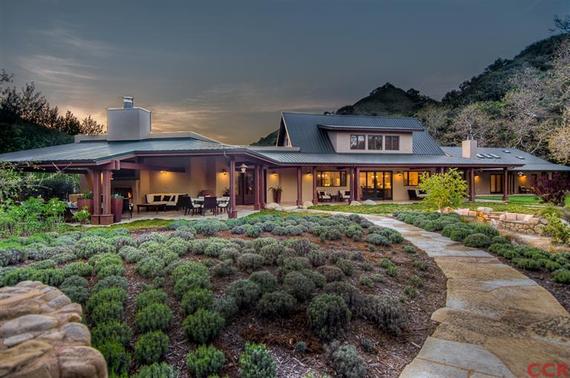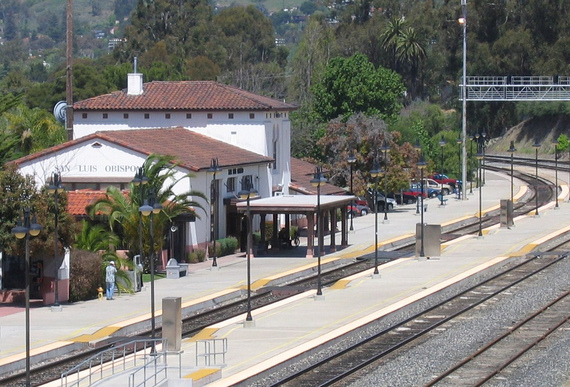
Roughly halfway between Silicon San Francisco - and the window-breaking, Google-Bus-halting envy its digital strivers engender - and LA's brain-depleting smog, sits the crown jewel of the California Central Coast: San Luis Obispo. If you're traveling to this good, kind burg, you need to slow down. Slow way down.
I don't say "slow," however, as an overused pun on SLO, the town's moniker. I mean that sincerely, like the people here, who do not possess even a smidge of my manic Family Guy meets South Park satirical edge (Bubblegum Alley is about as weird as SLO gets).
And that's okay. When I travel away from my bicoastal/bipolar redoubts of New York and L.A, I seek a break from twisted cultural norms. SLO provides that.
You see, San Luis (pron. like St. Louis, not St. Louie) Obispo has commingled the earnest Navy town probity of San Diego with the straightforward, no-hype competency of the American Midwest and Canada (minus the self-righteous condescension of our northern neighbors, the late great Rob Ford notwithstanding).
Since my last visit to SLO in 1998, while preparing The Mad Monks' Guide to California ((Frommer's/Macmillan), it's clear that the "SLO-cals" - many of whom escaped from more neurotic ports of call - are now keenly aware of the fragile nature of their precious Pinot Noir, and have taken concrete steps to preserve it.
For instance, SLO's low density is by design. The city mandates that housing stock can only grow 1% per year. Moreover, SLO has created a 54,000 acre green belt (ala Portland, Oregon and Napa, CA) - with myriad hiking trails to the city's signature hillside natural attractions (see #picsonpeaks) - to ensure that the urbanization and sprawl, which permanently altered other pristine California enclaves, does not migrate here.
Further towards that end, city ordinance mandates that building height be kept at a reasonable 60 feet. To expand beyond that limit, developers must go through a daunting labyrinth of regulations. So far, no takers.
Through such strict oversight, SLO enables empirically validated conditions for well-being, even at the expense of business development. Though I was not previously aware of this, San Luis Obispo is a major "blue zone." That is, it consciously fosters healthy, meaningful longevity in its residents, or so blue zone theory goes.
For example, SLO claims to be the first American city to not only ban smoking in restaurants and bars, but also in parks, in front of office buildings, and in the workplace. In addition, SLO maintains strict limits on the size and nature of signs. Moreover, thanks to ProtectScenic101 (PS101), you will see few billboards in SLO as you drive up the 101 past the citadel of kitsch and camp, The Madonna Inn (if only they used more pink), and over the Cuesta Grade to the organic wine-growing capital of Paso Robles.
Since the 1980s, SLO has also banned drive-through restaurants (no surprise that the city claims to have among the lowest rates of obesity in the nation). It also maintains sundry bike lanes, convenient and plentiful bus stops, and requires that all new buildings have bike lockers and showers. That's all pretty incredible, though it could rightly be classified as a Libertarian's nightmare of government overreach.
A side effect of this hygienic, slow-growth ethos is that real estate prices have ballooned. Your average 3BR home in SLO's 93405 zip code runs over $900,000.
Nevertheless, it means that you can easily spy several of the Nine Sisters volcanic hills or "plugs" (1559-foot Bishop Peak being the tallest) that surround this green-splattered - thanks to this year's El Nino - Mecca. The most famous sister, 581-foot Morro Rock, is in the beautifully dystopian - thanks to the decommissioned Morro Bay Power Plant - fishing village of Morro Bay.
Locals lovingly refer to their home as "Three Stacks and a Rock." However, this popular bird-watching destination - home to the late fitness guru Jack LaLanne - has other surprising highlights, such as The Shell Shop, which "excels in shells," like the sexy Black Murex from Baja.
Wherever you go in SLO (less so in its neighboring beach havens), you quickly appreciate the effort residents expend to keep their city from turning into another chain-littered, burl and saltwater taffy tourist trap. Don't get me wrong: SLO is not yet in the league of Aspen, Telluride and Santa Fe for boho-bourgeoise charms, but, to my surprise, it's methodically moving in that direction, without, hopefully, losing the earnest, considerate kindness that is its signature hallmark.
But don't mistake those time-honored courtesies - more often found in the American South or my home state of Nebraska - with gauche stupidity. Home to increasingly competitive California Polytechnic State University (Cal Poly), this is a culturally savvy oasis, which contains both an Apple Store and a Whole Foods (amazing for a city of only 46,000). Its exceptionally well-run San Luis Obispo Film Festival (covered in a subsequent review) and Festival Mozaic summer music series (to be sampled on a future visit) reflect that. The city even has an Events app, so you can carefully plan your next SLO arts, culture, food and wine adventure.
More to the point, here in SLO, that old tree-lined California of wide streets and American Craftsman homes finds no struggle to survive. Historic architecture thrives too. For example, across from where my film Master Debaters recently screened at the sweet, programmatically intelligent Palm Theater, sits the brick Ah Louis Store. Louis, a Gold Rush era immigrant from China's Guangdong Province, oversaw Chinese immigrant crews that constructed the area's Pacific Coast Railway Avila-Port Harford spur and the tunnels heading over the area's Santa Lucia Mountain Range.
Also downtown, you will find the beautifully preserved Mission San Luis Obispo de Tolosa, with sylvan San Luis Creek running nearby, where Cal Poly students sneak a kiss late night under the stars.
In addition, there's the spectacular Fremont Theater, where Ann-Margret, Alan Arkin and I shared air during the recently concluded SLO Film Fest.
You think all this idyllic perfection would make the locals smug, with the elitist women-who-lunch attitude one finds in other pristine, carefully preserved boutique cities like Santa Barbara, which I previously excoriated in this space. Not the case, at least not yet, in SLO.
Here the locals are earnest and dependable, though not flashy. They move slowly and steadily, if humorlessly. And they close up shop, and roll up the sidewalks, at reasonable hours.
I have a pet, highly subjective explanation for this orderly, homespun goodness: San Luis Obispo is surrounded by agriculture of all kinds, including a luffa farm). However, most prominent of these Arcadian pursuits is viticulture. In its neighboring Edna and Arroyo Grande valleys, the SLO area produces some of the most respected wines in the world. Here the long growing season yields more than 23 varietals, including world-renowned Viognier, Abarino and Grenache.
Wherever I have traveled in this country, when agriculture is actively present both in cultivation and in farmers markets (every Thursday, SLO hosts the second largest in the nation), the locals tend to be more grounded, decent and humane. That is surely true of SLO and the Five Cities Area (Arroyo Grande, Grover Beach, Oceano, Pismo Beach and Shell Beach) that abuts SLO, though this sensibility extends out to nearby Avila Beach, Cayucos, Harmony, and lovely Los Osos as well.
You might say that this agrarian nobility has been hard-wired through practice - with a nod to Jean-Baptiste Lamarck - into San Luis Obispo County's DNA. For decades, the San Luis Obispo area was the destination of choice for Central Valley oil and farm workers escaping the summer heat. I can imagine wildcatter Daniel Plainview (from P.T. Anderson's classic There Will Be Blood) riding over from the oil fields of Taft to Pismo (from Chumash word "pimu" or tar) Beach and then mounting a hill to sample the human wares at a nearby bordello.
But now SLO wants to be slow in a deeper sense, more in keeping with the holistic health culture that, as historian Theodore Roszak has confirmed, originated in the Bay Area, and has now swept California and the planet. That would mean a richer kind of slow you feel after the friendly female transplants at East Well-Being and Tea spa, in SLO's elegant Heritage Plaza, have subjected you to one of their "running cupping" sessions (I have the back marks to prove it), followed by a slow, tender massage.
Or slow in the way one must feel after a weekend at the stunning, Tuscan-style Canyon Villa B & B in nearby Paso. It's a good, clean slow, that comes from being shorn of hyperconnectivity, and the edgy cynicism that comes with urban living.
You especially feel this restorative slowness walking SLO's side streets. Once you get a few blocks away from the main Monterey Street drag - and its friendly, if workmanlike, motels - you come across dozens of well-manicured homes that radiate quaint, quiet pre-War California living. You just wish Mildred Pierce (the Kate Winslet iteration) would bop out of one of those Spanish-style homes and hand you a piping hot apple pie. Or invite you in through her swinging door for herbal tea at her beautiful Formica table. It's that kind of town. A Leave it to Beaver outpost of the Central Valley that is not TV nice, but genuinely nice.
That's not to say all is peachy keen in this mash-up of surfers, ranchers, wine-growers and culture vultures. There's a fair share of cheezy corn pone littering the gorgeous beach towns near SLO (otherwise stunning Avila Beach seems particularly afflicted, though the bustling acai and quinoa hotbed of Kravabowl is a harbinger of enlightened things to come). And while SLO has admirably disallowed drive-through restaurants, the standard brewpub, pizza and Mexican food offerings still dominate this college town's culinary scene.
Nevertheless, SLO is committed to expanding and modernizing its farm-to-table offerings, as part of its push to sell itself as the new Napa. That is, a wine, craft beer and foodie destination that offers both stunning nature and myriad ways to decompress. Along these lines, the Draca, a smoked Porter with chiptole peppers from the friendly folks at Bang the Drum Brewery, is so insanely good it made this teetotaler reconsider his straight edge lifestyle choice. And I've heard good things about Sycamore Mineral Springs Resort outside Avila Beach, though I didn't get a chance to visit.
Unfortunately, the city still has work to do in modernizing and upgrading its lodging inventory. The evocative 17-room Granada Hotel & Bistro might be a step in that direction (I will have to see on a future trip). Nevertheless, SLO could use an official state visit from Chip Conley of Joie De Vivre fame, or maybe a field trip to Palm Springs' Modernist motel masterpieces in order to marry the accommodating service found at, say, the Sands, with a tighter and more novel sense of design, local history, food and amenities.
Such innovation is naturally encouraged by fiercer competition in the accommodation space. Unfortunately, the city's unreasonably tight restrictions on home-sharing services (e.g., Airbnb, VRBO/HomeAway) discourages such healthy competition.
You see, one unforeseen consequence of SLO's urban growth boundary, home construction limit, and building height restrictions has been to create a drastic shortage of housing inventory, and unnaturally high-priced inventory at that. This will in time force its growing cohort of tech and hospitality workers to car commute from longer distances because of the need for cheaper digs, thereby engendering the traffic snarls that sent many LA, San Diego and SF expats fleeing to uncongested SLO in the first place.
One of SLO's answers to this conundrum is to disallow short-term rentals unless one owns the property and it's one's primary residence. This actually works, however, to discourage competition and, thus, much-needed improvements in the city's hotel and motel inventory. As I've seen in dozens of other cities, one of the nice consequences of home-sharing services - and the stepped-up innovation, comfort, and customer service that they provide and encourage - is to force the lodging industry to up its game in turn. Hotels and motels won't be forced to do so in SLO, as long as the city's home-sharing restrictions remain in place.
Moreover, as an NYU study confirmed, allowing graduate students, professors, and working class and middle class renters to sublet out a room or two could provide the additional make-or-break revenue that allows them to remain in and contribute to SLO's economic and cultural diversity. Allowing second and third homebuyers to rent out their homes also brings in financially strong residents who can add to the city's housing inventory, and contribute philanthropically to the city's arts scene.
Until recently, the ability to home-share kept many of New York's amazing artists in the city. Now, as New York naively cracks down on home-sharing (based on a few horror stories that by no means represent the home-sharing norm), those long-term artists are forced to leave the city altogether. As the ruthlessly mercenary Monacos of New York and San Francisco have demonstrated, the so-called "cultural creatives" these cities hope to retain are caught in the middle: they make too much coin, or don't fit the right demographic profile, to qualify for low-income housing, but not enough coin to cover their city's stratospheric rent and cost of home ownership.
The net result of these restrictions for a place like SLO is that a charming progressive community can quickly become a haven for only the super-rich, who are, in turn, served by a growing class of Task Rabbits, who do the cleaning, shopping, lawn care, cooking, and errands for their wealthy clients, and serve the same gentry at area restaurants and wine bars, but who must commute in from far away rabbit holes in order to make ends meet. In fact, this is precisely what has happened in the famed gourmand capital of Napa, California, which SLO is beginning to model in more ways than one.
One thing I can say about San Luis Obispo residents and leaders is that they honestly and openly struggle with these concerns. And they listen very well to feedback. This gives me hope that this remarkably livable and lovable charmer - only six hours by Amtrak's Surfliner, four hours by car, and thirty minutes by plane from my L.A. home - will get this delicate mix right.
James Marshall Crotty is the peripatetic publisher of Monk: The Mobile Magazine, author of How to Talk American (Houghton Mifflin), and director of the urban debate documentary Crotty's Kids. He writes about the intersection of travel, culture, and politics. To learn more, please visit www.jamescrotty.com.
